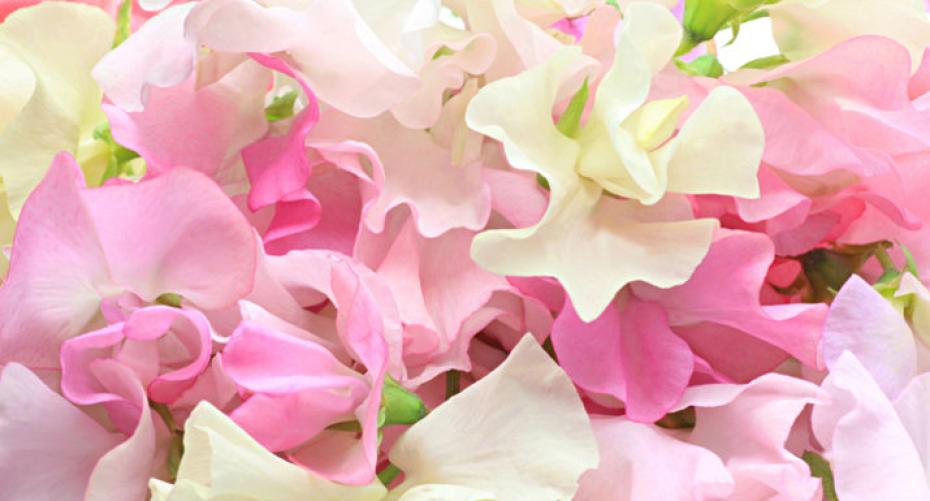Their intoxicating scents and fabulous show of colours make sweet peas a must for your garden.
Sweet peas evoke thoughts of glorious cottage gardens bursting with a proliferation of flowers in a rainbow of colours. Who can forget the added attraction of their delicious heady scent? Not only do they make truly garden-worthy flowers, blooming for a minimum of two months during the summer, they also provide glorious cut flowers for the home. It's true that sweet peas perform much better if the flowers are not allowed to set seed, so regular cutting is essential.
Sweet peas are easy to grow. Sow seeds in October or January and overwinter in a cold frame or greenhouse. But don't despair if you missed out on planting time. We have a variety of sweet peas in stock at the moment.
Make sure you plant sweet peas in a sunny spot. Ideal garden conditions will also include well-cultivated soil fed with a proprietary feed such as Growing Success Organic Bedding Plant Fertiliser.
 Lathyrus odorata are climbers that require support to look their best. Allow them to grow naturally up an obelisk to create an appealing focal point that every garden can accommodate. Patio gardeners can also experience the joy of the sweet pea with low-growing types such as the Cupid series. The gorgeous ‘Pink Cupid' produces pink and white bi-coloured flowers ideal for planting alone or in combination.
Lathyrus odorata are climbers that require support to look their best. Allow them to grow naturally up an obelisk to create an appealing focal point that every garden can accommodate. Patio gardeners can also experience the joy of the sweet pea with low-growing types such as the Cupid series. The gorgeous ‘Pink Cupid' produces pink and white bi-coloured flowers ideal for planting alone or in combination.
Tips for Success
- Prepare and feed your ground before planting
- Start of seeds in Autumn/Winter
- Plant out in early spring
- Plant in full sun
- Keep well watered throughout the season
- Cut, cut and cut again. Don't let the plants go to seed
- Tie in plants to their supports regularly
- Feed as necessary (let your plants be your guide) throughout the season. Ask us for advice on suitable products
Favourite Sweet Peas
Mixtures
Superb range to suit all situations. Best for first-time growers.
- ‘Old Fashioned' or ‘Cottage Garden Mixed' - for colour and height
- ‘Cupid' - only grows to 30cm; trails along the ground
- ‘Continental Mixed' - suitable for container or obelisk
- ‘Flower Arranger Mixed' - more unusual colours and longer stems
Grandiflora (Heirloom)
The original sweet pea with smaller flowers than the Spencer types.
- ‘America' - crimson red stripes on a white background
- ‘Black Knight' - deep maroon flowers
- ‘Captain of the Blues' - deep blue and purple bi-colour
- ‘Cupani' - purple/blue flowers with a very strong scent
- ‘Lord Nelson' - well scented with indigo blue petals that darken at the edges
- ‘Mrs Collier' (cream) - masses of rich cream flowers with greenish buds
 Spencer straight colours
Spencer straight colours
Strong growers that are also good in containers
- ‘Air Warden' - prolific, bright scarlet-cerise flowers
- ‘Beaujolais' - large flowered deep burgundy colour, one of the darkest. Well scented
- ‘Blue Velvet' - long stems with rich deep blue flowers. Well scented
- ‘Leamington' - large deep lavender flowers on long stems. Strong scent
- ‘Mrs R Bolton' - strong soft pink with large flowers. Well scented
- ‘Princess Elizabeth' - salmon pink flowers over a cream petal. Well scented
- ‘Swan Lake' - pure white - one of the best. Good scent and stem length
- ‘Winston Churchill' - crimson flowers with well waved petals. Good grower
Premium range
Spencer types bred mainly for the show bench. Available with bigger floweras and longer stems, often in excess of 15 inches.
- ‘Gwndoline' - large-flowered, bright rose and white flowers, with a strong scent. One of the very best.
- ‘Charlie's Angel' - exceptionally pale blue, well ruffled flowers
- ‘Royal Wedding' - large pure white flowers on long stems, reliable, well scented
- ‘Jilly' - yellow buds open to a pale cream white, well scented, strong grower
A highlight last year was the ‘Help for Heroes' mix which is a sweet pea mixture with a very special mission. It was created to support the Help for Heroes charity appeal, which strives to make a real difference to the lives of servicemen and women wounded in Britain's current conflicts. The colours signify the three armed forces. Light blue represents the Royal Air Force, dark blue the Navy and red the Army.


